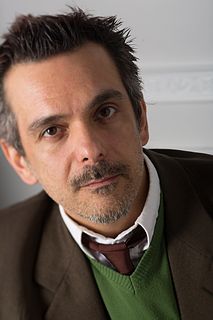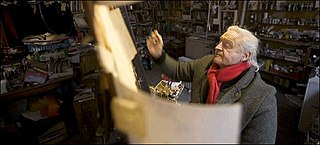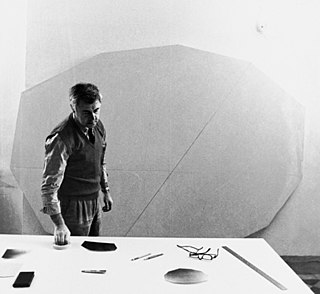Eltjon Valle | |
|---|---|
 | |
| Born | 1984 |
| Nationality | Albanian |
| Occupation | Artist |
Eltjon Valle (born 1984 in Qyteti Stalin, Albania), is an artist. He lives and works in Milan. [1]
Eltjon Valle | |
|---|---|
 | |
| Born | 1984 |
| Nationality | Albanian |
| Occupation | Artist |
Eltjon Valle (born 1984 in Qyteti Stalin, Albania), is an artist. He lives and works in Milan. [1]
Since the early 2000s when he moved to study art, at the Accademia di Belle Arti di Brera. [2] He finished his bachelor's degree in 2007, and a master's degree in fine arts in 2009. In Milan he became one of the best known artists of his generation, since he was a student. His medium was oil, and he's been using it in his although naturalistic representation. Thanks to his architectural landscapes, his portraits and his site specific interventions, he is one of the actually active artists living in this city.
The beginnings of Valle as a painter, belong to his hometown, which under the communism was an industrial basement of petrol. This element, oil, is the first one that Valle started painting with, during his early childhood. Valle has kept it on by then, as a common denominator to some of his most important series of paintings. Such as the series of the cursed writers of the 20th century (started in 2006).

Or the series of flowers (2012). Or the series of the homages he pays to fashion.
One of his most representative series of works are the "land pieces", actually pieces of polluted land he collects in the country of Marinz (Al), and engraces with butterflies.
Petrol is one of the main factors of global changes that regard development and pollution, and Valle through his paintings and other types of work, keeps investigating the negative and 'positive' effect of this exploitation on the everyday life, and its consequences on the living and perception of modern landscape. He has participated to some collectives and also to some personal exhibitions.
The main project of Valle in this context is the Marinz Project. [2] [3] [4] This is a site specific based one. Marinz is a small country close to that industrial city where Valle grew. In the uncontaminated communist Albania, it was the polluted exclusion. Since the year 2012 the artist has been painting polluted flowers of Marinz, while taking its land pieces to transform them into art works, by drying and adorning them, acclimating and taming them, making them so to say, domestic. [3] Valle seems to sustain that everything is nature, even pollution. That's why, he tries to witness that a new beauty appeared in our time, the polluted one.

Some of his main exhibitions have been:

Domenico Zampieri, known by the diminutive Domenichino after his shortness, was an Italian Baroque painter of the Bolognese School of painters.

Stefano W. Pasquini is an Italian contemporary artist, writer and curator living in Italy.
He works with paintings, performance, photography and installation. He also publishes a magazine called Obsolete Shit.

Nikoll Idromeno, better known as Kolë Idromeno, was an Albanian painter, sculptor, architect, photographer, cinematographer, composer and engineer during the Albanian Renaissance in the nineteenth century. He is widely regarded as a precursor of both realism and landscape art in Albania.

Ibrahim Likmetaj Kodra was an Albanian painter.
Gino De Dominicis was an Italian artist.

Ludovico De Luigi is a contemporary Italian sculptor and painter living in Venice.
Trento Longaretti was an Italian painter. He studied at the Brera Academy in the 1930s, where he was taught by renowned artists, including painters Aldo Carpi and Pompeo Borra, and sculptors Francesco Messina and Marino Marini. He stated that painting is an "elixir for long life", and continued to paint and exhibit as a centenarian.
Piero Golia is a conceptual artist based in Los Angeles.

Patrick Mimran is a contemporary French multimedia artist, composer, and the former CEO of Lamborghini. He is most widely known for Lamborghini's turn-around in the early 1980s and his art exhibit, "The Billboard Project".

Ettore Tito was an Italian artist particularly known for his paintings of contemporary life and landscapes in Venice and the surrounding region. He trained at the Accademia di Belle Arti in Venice and from 1894 to 1927 was the Professor of Painting there. Tito exhibited widely and was awarded the Grand Prize in painting at the 1915 Panama–Pacific International Exposition in San Francisco. In 1926 he was made a member of the Royal Academy of Italy. Tito was born in Castellammare di Stabia in the province of Naples and died in Venice, the city which was his home for most of his life.
Emanuele Cavalli (1904–1981) was an Italian painter belonging to the modern movement of the Scuola Romana. He was also a renowned photographer, who experimented with new techniques since the 1930s.

Antonio Papasso is an Italian painter and engraver.

Francesco Podesti was an Italian painter, active in a Romantic style. Together with Francesco Hayez and Giuseppe Bezzuoli, he is considered one of the greatest Italian painters of the first half of the 19th century. He was prolific in his large canvases on historical subjects. He is best known for his fresco work, including those in the Hall of the Immacolata in the Vatican Museum.

Giuseppe Amisani was an Italian portrait painter of the Belle Époque.
Florian Vika is an Albanian contemporary painter and visual artist from Tirana. He was graduated in the Academy of Fine Arts, Florence, Italy in 2004. His art conception is based in the reconstruction of the new values lost from ancient art which remains in every time and sharing those with post modern ones created from Picasso. This way of creating by Florian was appreciated from the Italian professors of Accademia di Belle Arti di Firenze.
Ernesto Treccani was a visual artist, writer and political activist.

Fernando Leal Audirac is a visual artist, painter, sculptor, etcher and designer. He is a specialist of classical painterly techniques, such as fresco, encaustic, egg tempera, oil, that he reinterprets in a contemporary key, combining them with modern technology.

Maurizio Pellegrin is an Italian and American visual artist. He works with installations, photography and video. He is married and has two sons.

Rodolfo Aricò was an Italian painter and theatre set designer.
Franco Grignani was an Italian architect, graphic designer and artist. He is best known for black and white graphics, particularly the Woolmark logo, which was voted 'Best Logo of all Time' by Creative Review Magazine in 2011.